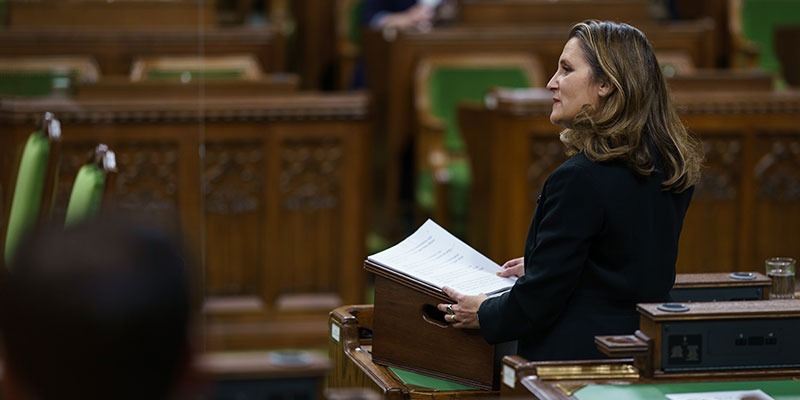Fiscal update—federal finances in worse shape than previously thought

The Trudeau government released its fall fiscal update for 2020, which included more spending measures and grimmer deficit projections than previously anticipated. Unfortunately, the federal government also demonstrated little concern for the long-term health of federal finances.
The update projects 2020/21 program spending will reach $621.4 billion—an increase of $28.8 billion since the “snapshot” provided in July 2020 and 83.6 per cent from spending in 2019/20. Put differently, per-person federal program spending will reach an estimated $16,350 in 2020, by far the highest level (inflation-adjusted) in Canadian history. For reference, per-person spending (inflation-adjusted) was $7,623 during the height of the Second World War.
The pronounced increase in spending compared to July’s projections demonstrates the Trudeau government’s repeated inability to control spending. Projections for federal revenues have actually increased by $6.6 billion over the last four months, but nearly $30.0 billion more in spending has completely wiped out the potential fiscal improvement from this new revenue. This represents a familiar trend, as the Trudeau government has frequently offset higher-than-expected revenues with new spending initiatives since taking office.
Worryingly, the spending estimates in the update also exclude the economic stimulus, which Finance Minister Chrystia Freeland indicated would range between $70 billion to $100 billion over the next three years.
Federal spending on programs such as the Canada Emergency Response Benefit (CERB), wage subsidies and enhanced employment insurance have attempted to stabilize incomes for individuals and businesses throughout the pandemic. However, costs for some programs have exceeded original expectations and today Ottawa announced new funding for temporary top-ups to the Canada Child Benefit (CCB) and Canada Emergency Wage Subsidy (CEWS).
Moreover, additional permanent spending initiatives such as national childcare and pharmacare are expected to be introduced—at least partially—next spring in Budget 2021. These additional programs mean more spending and budget deficits beyond those outlined in the update, which will pose significant problems for the long-term health of federal finances.
Since spending is up significantly and revenues are down from 2019/20 levels, the expected result is a massive deficit of $381.6 billion this year. To put this in perspective, this is approximately $38.4 billion higher than the projections in July’s fiscal snapshot and nearly 20 times larger than the original 2020/21 deficit estimate in last year’s budget.
A sizeable budget deficit also brings more federal debt. Between 2015/16 and 2019/20, the Trudeau government accumulated $87.0 billion in federal debt—before the full effect of COVID. Canada is now on track to reach a federal net debt burden of $1.2 trillion by the end of the fiscal year and this could potentially climb to almost $1.5 trillion by 2025. Moreover, federal debt as a share of the economy is expected to increase from 31.2 per cent in 2019/20 to 50.7 per cent in 2020/21.
So why should Canadians be concerned about the state of federal finances?
Economic research shows more government debt means slower economic growth, as it increases uncertainty for households and investors, and imposes the cost of current spending on future taxpayers. In other words, growing government debt will harm the economy and raise taxes for Canadians in the future.
Rising interest rates or downgrades from rating agencies would bring further challenges for government finances, as future debt-interest costs are expected to increase and claim more tax revenue while debt accumulation compounds at a fast rate. Young Canadians, in particular, will bear the burden of paying these debt-interest costs.
Possible rising interest rates, an aging population and the absence of meaningful fiscal anchors also threaten the long-term sustainability of federal finances. This is especially concerning given that further spending measures are planned next year and have not been accounted for in today’s fiscal update. Without changes in policy, Canada’s fiscal challenges will likely only get worse.
Sooner rather than later, the Trudeau government must present a proactive long-term plan that ensures fiscal prudence by returning to balanced budgets in the post-COVID period. Otherwise, the burden on Canadians will continue to grow for years to come and the economy will suffer.
Author:
Subscribe to the Fraser Institute
Get the latest news from the Fraser Institute on the latest research studies, news and events.

